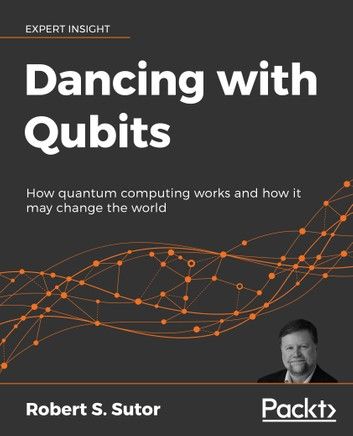Dear Reader,
Recently I had the pleasure of reading Dancing with Qubits: How quantum computing works and how it can change the world by Robert Sutor, published by Packt Publishing, an introductory book on quantum computing (or QC for short”).
In this review, I’d like to not only share my thoughts on the book, but also give you an idea of who would benefit most from reading it.
This review consists of the following sections:
- General overview
- Structure
- Part 1 – math
- Part 2 – qubits
- Praise and criticism
- Summary

General overview
Dancing with Qubits is an introductory, textbook-style book that covers all of the basics necessary to understanding how quantum computing works. It presents some well-known quantum algorithms (like Grover’s or Shor’s) and hints at some practical aspects of building and using quantum computers.
The author, Robert Sutor, is currently the VP of Strategy and Ecosystem at IBM Q (IBM Q is the division of IBM that is doing QC). He is responsible for driving the strategy, ecosystem, and awareness for the IBM Q quantum computing program.
You can learn more about him on his website or follow him on Twitter.
Structure
Dancing with Qubits is very clearly structured. Apart from the clear structure of the chapters, it uses visual cues to highlight the most important pieces of information and asks the reader questions that help you deepen your understanding. It also contains many references (rather high-quality as far as I can tell) for those who want to explore further.
The book starts with a short chapter which motivates why do we care about developing QC as a technology. I really liked this part – it’s realistic and points out some use cases which won’t be feasible on near-term devices (e.g. big data). Even though this section is short, it serves its goal and makes the reader want to learn more about QC.
After this introduction, we get an “official” first part – almost 200-pages long – about the math needed to understand the basics of QC. The author explains concepts from number theory, linear algebra and probability.
The second part (slightly more than 200 pages) is about quantum computing itself. It covers the basics (notation, gates and bloch sphere), some fundamental concepts and algorithms, and finally it discusses aspects of the physical implementation of quantum computers.
Part 1 – Math
Even if I hadn’t known that the author holds a PhD in mathematics, it would have been an easy guess after having read this part.
I think Part One would enable someone with a high-school-math background to obtain the tools needed to understand the basics of QC. If you don’t know linear algebra, it probably won’t be enough to give you a good intuition, but hey, you have to start somewhere. To quote the author: “I’m only going to cover the bare minimum we need for quantum computing, plus 10%. Why extra 10%? It’s because some properties and connections are just too interesting to ignore!”
And if you took linear algebra classes some time ago, this section might help to refresh some topics or even learn a couple of new facts. In the worst case scenario, you can just skip whatever chapters you are familiar with and jump straight to the second part.
Another important topic described in this part is the introduction to “classical” boolean circuits and gates – NANDs, XORs, etc.
Part 2 – QC
In the second part of the book I finally got what I wanted — some quantum computing. Again, we start from the very basics — defining what qubits and gates are and the math behind them. Then, we naturally move to multiple qubits, entanglements and tensor products.
I have to say that I particularly liked how the tensor product has been explained: with ice cream and sauce.
The following two chapters explain the basics of quantum algorithms and their most important building blocks: teleportation, amplitude amplification, quantum Fourier transform, phase estimation etc. It’s easy to follow, with all the equations and transformations of the states written down. It finishes with the explanation of factoring and Shor’s algorithm.
So far, we have not really touched on physics — it has been pure math up to this point. In the following chapter, the author introduces us to some physical properties of the quantum systems, like the interference of photons or the decoherence of qubits, which leads to the introduction of basic error correction methods, the definition of quantum volume etc.
The last chapter provides us with many questions that might help you understand your potential role in QC better, as well as whether QC might be useful for you or what else you still have to learn.
Praise and criticism
I have already pointed out many things I like about this book, but there are still a few things left:
- I really enjoyed the mathematical approach to many topics,
- The pace is rather slow, so it’s easy to understand,
- Even though the author is obviously biased, this book isn’t really tooting IBM’s horn,
- There are no moments of “the proof is left as an exercise to the reader”.
However, there are still some things I found less impressive:
- I’m quite disappointed that a book written in 2019 doesn’t cover variational algorithms,
- I hoped for a more in-depth book,
- Even though it doesn’t blatantly promote IBM , I don’t think it includes the name of any other company working on QC,
- There were some places where I wasn’t happy with the explanation or could’ve used an example.
Summary
Overall, I think Dancing with Qubits is a good introduction to quantum computing, especially for undergraduates or people who don’t necessarily have a math background.
Additionally, I think it would be best received by people with a knack for math. However, if you already know the basics of QC, you will find little new content here.
If you’d like to buy it, I you can use the following link: https://www.goodreads.com/book/show/49928907-dancing-with-qubits?from_search=true&from_srp=true&qid=CDOCWD8rbj&rank=1.
Have a nice day!
Michał
